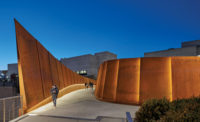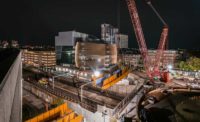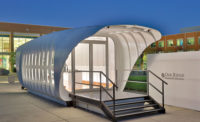When architects from Payette developed the concept for the Interdisciplinary Science and Engineering Complex (ISEC) at Northeastern University, they conceived its six-story-tall central atrium as the building’s centerpiece, as well as being a student hub for the expanding campus. They envisioned a dramatic and lively space topped by a generous skylight. But as they developed and refined the scheme, the initial mostly glass roof was transformed into one with three discrete cone-shaped apertures. The aim of this “right-sizing” process, according to Arup lighting designer Jake Wayne, was to eliminate glare in the atrium and ensure quality daylight in adjacent spaces—namely laboratory write-up areas. These look onto the atrium from multiple levels through a glass wall. For those times when daylight is not sufficient, the write-up spaces are illuminated with Peerless linear pendants that bounce light off the ceiling. The atrium also has supplemental LED lighting, including Selux spotlights tucked into balconies at its perimeter and Lumenpulse RGBW linear projectors concealed in coves at the base of the skylights. The latter fixture provides a soft glow so that the skylights are always legible, says Kevin Sullivan, Payette president. Although the building’s fixtures are wired, its Lutron Quantum control system’s components, such as occupancy sensors, photo sensors, and switches, are for the most part wireless, a characteristic that streamlined their installation, says Wayne.
Next case study: R/GA Office New York by Foster + Partners and Tillotson Design Associates
Back to "Continuing Education: Lighting Controls" essay









Post a comment to this article
Report Abusive Comment